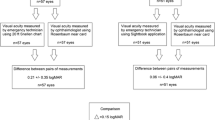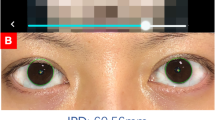Abstract
This study is aimed at describing the TreC Oculistica novel smartphone App that facilitated the clinical practice of pediatric ophthalmology and strabismus during the COVID-19 pandemic and at reporting on the validation of visual acuity tests in a home setting. The Trec Oculistica smartphone App was prescribed to eligible patients at the Pediatric Ophthalmology and Strabismus Clinic, Ophthalmology Unit of Rovereto Hospital, between September 2020 and March 2022. Four key indicators were identified for monitoring visual and visuo-motor functions remotely: visual acuity, ocular motility, head posture, and color vision. Clinicians selected few mobile applications (iOS, Android) and printable materials within the Trec Oculistica App: the Snellen Chart Visual Acuity App, the 9Gaze App, the eyeTilt App, the Color Blind test App, the LEA Symbols pdf, and the Snellen Chart pdf. All patients, aged 4 and older, were screened at home for visual acuity at 3 m and later in the clinic (LEA Symbols cabinet or Snellen computerized optotype). The 9Gaze, the eyeTilt, and the Color Blind test Apps were only recommended to a subset of patients based on clinical suspicion or diagnosis. The Wilcoxon signed rank sum test and weighted Cohen’s kappa coefficient were applied to compare pairs of scores from different settings. The Trec Oculistica App was downloaded and activated by 97 patients or their caregiver. 40 patients were tested at home using the 9Gaze App, 7 used the eyeTilt App, and 11 used the Color-Blind test App. Families reported that all the Apps were easy and intuitive to use; clinicians reported that measurements were reliable. 82 eyes of 41 patients (mean age 5.2 years, SD ± 0.4, range 4.4–6.1) were tested for visual acuity using the self-administered LEA Symbols pdf. 92 eyes of 46 patients (mean age 11.6 years, SD ± 5.2, range 6–35) were evaluated using the self-administered Snellen Chart Visual Acuity App or the Snellen Chart pdf. Home median visual acuity score was statistically different from that registered in clinical setting for both the LEA Symbols pdf (P-value = 0.0074) and the Snellen Chart App and pdf (P-value = 0.0001). The strength of agreement was 0.12 (slight) for the LEA Symbols pdf, 0.50 (moderate) for the Snellen Chart Visual Acuity App, and 0.69 (substantial) for the Snellen Chart pdf.
Conclusion: The novel TreC Oculistica smartphone App was a useful tool for facilitating the clinical practice of pediatric ophthalmology and strabismus during the COVID-19 pandemic. In the follow-up of strabismus patients and patients with suspected inherited retinal diseases, the 9Gaze, eyeTilt, and Color Blind test applications were deemed to be intuitive and easy to use by families and were considered reliable by clinicians. In a home setting, visual acuity tested by means of Snellen Charts was moderately congruent with the in-office examination. On the contrary, agreement was poor in younger children tested with the LEA Symbols pdf.
What is Known: • Teleophthalmology enables clinicians to evaluate patients’ ocular diseases remotely and various tools are helpful for screening, follow-ups and treatment. • Smartphones can currently be used to obtain ocular images and vision measurements of patients’ eyes and this information can be shared with the ophthalmologist for further evaluations and medical management (mhealth). |
What is New: • Smartphone Apps can be successfully used in a hybrid teleophthalmology service concerning first visits and follow-ups. • Apps and printable materials are easy, intuitive to use for patients and also reliable for clinicians. |





Similar content being viewed by others
Abbreviations
- APSS:
-
Azienda Provinciale per i Servizi Sanitari
- PAT:
-
Provincia Autonoma di Trento
- FBK:
-
Fondazione Bruno Kessler
- Apps:
-
Smartphone applications
References
Chodosh J, Holland GN, Yeh S (2020) Important coronavirus updates for ophthalmologists. [Updated March 1, 2021] Available from: https://www.aao.org/headline/alert-important-coronavirus-context
Li JPO, Liu H, Ting DSJ, Jeon S, Chan RVP, Kim JE et al (2021) Digital technology, tele-medicine and artificial intelligence in ophthalmology: a global perspective. Prog in Retinal and Eye Res. https://doi.org/10.1016/j.preteyeres.2020.100900
Vipin Das A, Mididoddi S, Kammari P, Davara NP, Loomba A, Khanna R (2019) App-based tele ophthalmology: a novel method of rural eye care delivery connecting tertiary eye care center and vision centers in India. Hindawi Int J Telemed App 8107064. https://doi.org/10.1155/2019/8107064
Stewart C et al (2021) Reliability of telemedicine for real-time paediatric ophthalmology consultations Br J Ophthalmol 1–7. https://doi.org/10.1136/bjophthalmol-2020-318385
Malfatti G, Racano E, Delle Site R, Gios L, Micocci S, Dianti M, Molini PB, Allegrini F, Ravagni M, Moz M, Nicolini A, Romanelli F (2021) Enabling teleophthalmology during the COVID-19 pandemic in the Province of Trento, Italy: design and implementation of a mHealth solution. PLoS One 16(9):e0257250. https://doi.org/10.1371/journal.pone.0257250. PMID: 34506578; PMCID: PMC8432860
UPMC Children‘ s Hospital of Pittsburgh Department of Ophthalmology (2020) Measuring visual acuity at home. (YouTube) 2020. https://www.youtube.com/watch?v=Clp_axzAfeQ
Telehealth Resources Testing Vision & Eye Movements Useful Apps and Printable Charts in Orthoptics Australia Web-site 2021. Available from: https://www.orthoptics.org.au/public/39/files/Telehealth%20Resources%20for%20Clinicians%20V3.pdf
UPMC Children‘ s Hospital of Pittsburgh Department of Ophthalmology (2020) Taking 9 Gaze photos from home. (YouTube) 2020. https://youtu.be/mZH8lCTDnoo
Cotter S, Cyert LA, Miller JM et al. Vision screening for children 36 to <72 months: recommended practices. Optometry and Vision Science: January 2015 Volume 92-Issue 1-p 616: https://journals.lww.com/optvissci/toc/2015/01000, https://doi.org/10.1097/OPX.0000000000000429
AAO Preferred Practice Pattern “Pediatric Eye Evaluations” (2017) Available from: https://www.aao.org/preferred-practice-pattern/pediatric-eye-evaluations-ppp-2017
Allaboutvision.com (Internet) US (2021) Snellen Eye Chart. Available from: https://cdn.allaboutvision.com/images/snellen-chart.pdf
Rodin A, Shachak A, Semenova N (2017) Mobile apps for eye care in Canada: an analysis of the iTunes Store JMIR Mhealth Uhealth 5(6): e84. https://doi.org/10.2196/mhealth.7055
Silverstein E, Williams JS, Brown JR, Bylykbashi E, Stinnett SS (2021) Teleophthalmology: evaluation of phone-based visual acuity in a pediatric population. AJO Volume 221, P199–206. https://doi.org/10.1016/j.ajo.2020.08.007
Author information
Authors and Affiliations
Contributions
All authors contributed to the study conception and design. Material preparation, data collection, and analysis were performed by Racano Elisabetta, Malfatti Giulia, Pertile Riccardo, Delle Site Roberta, Romanelli Federica, and Nicolini Andrea. The first draft of the manuscript was written by Racano Elisabetta, and all authors commented on previous versions of the manuscript. All authors read and approved the final manuscript.
Corresponding author
Ethics declarations
Ethics approval
This is an observational study. The APSS Trento Ethics Committee has confirmed that no ethical approval is required.
Consent to participate
Informed consent was obtained from all individual adult participants (or children’s parents/guardians) included in the study.
Consent to publish
The authors affirm that human research participants (or children’s parents/guardians) provided informed consent for publication of the image in Fig. 2 and videoclips.
Competing interests
The authors declare no competing interests.
Additional information
Communicated by Peter de Winter
Publisher's Note
Springer Nature remains neutral with regard to jurisdictional claims in published maps and institutional affiliations.
Supplementary Information
Below is the link to the electronic supplementary material.
Supplementary file1 (MP4 16702 KB)
Supplementary file2 (MP4 30532 KB)
Supplementary file3 (MOV 13906 KB)
Supplementary file4 (MP4 3574 KB)
Supplementary file5 (MP4 5270 KB)
Rights and permissions
Springer Nature or its licensor (e.g. a society or other partner) holds exclusive rights to this article under a publishing agreement with the author(s) or other rightsholder(s); author self-archiving of the accepted manuscript version of this article is solely governed by the terms of such publishing agreement and applicable law.
About this article
Cite this article
Racano, E., Malfatti, G., Pertile, R. et al. A novel smartphone App to support the clinical practice of pediatric ophthalmology and strabismus: the validation of visual acuity tests. Eur J Pediatr 182, 4007–4013 (2023). https://doi.org/10.1007/s00431-023-05058-1
Received:
Revised:
Accepted:
Published:
Issue Date:
DOI: https://doi.org/10.1007/s00431-023-05058-1




